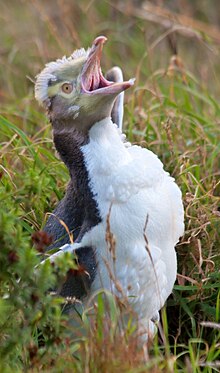Megadyptes
It has been suggested that this article be merged into Yellow-eyed penguin. (Discuss) Proposed since October 2023. |
| Megadyptes | |
|---|---|

| |
| Scientific classification | |
| Domain: | Eukaryota |
| Kingdom: | Animalia |
| Phylum: | Chordata |
| Class: | Aves |
| Order: | Sphenisciformes |
| Family: | Spheniscidae |
| Genus: | Megadyptes Milne-Edwards, 1880 |
| Species | |
| |
Megadyptes ("large diver") is a genus of penguins from New Zealand.
Species
The
Range
Until recently, it was assumed that yellow-eyed penguins were widespread and abundant before the arrival of Polynesian settlers in New Zealand. However, genetic analysis has since revealed that its
A 2019 study recommended classifying the Waitaha penguin as M. a. waitaha, a subspecies of the extant yellow-eyed penguin.[2] If this taxonomic revision is confirmed, then Megadyptes antipodes is native to mainland New Zealand after all.
A dwarf subspecies from the Chatham Islands, M. a. richdalei, is extinct.[2] The modern population of yellow-eyed penguins does not breed on the Chatham Islands.
Today, yellow-eyed penguins are found in two distinct populations.
References
- ^ PMID 19019791.
- ^ PMID 30722030.
- ^ "Sentinels of change: prehistoric penguin species raise conservation conundrum". Sciblogs. Retrieved 2019-09-29.
- ^ "New penguin species found in New Zealand". www.adelaide.edu.au. Retrieved 2022-04-22.
- ^ a b "Distribution and habitat". Yellow-eyed Penguin Trust. Retrieved 2019-09-29.
- ^ "Yellow-eyed penguin | New Zealand Birds Online". www.nzbirdsonline.org.nz. Retrieved 2019-09-27.
- ^ a b "Yellow-eyed penguin/hoiho". www.doc.govt.nz. Retrieved 2019-09-29.
- S2CID 205361804.
